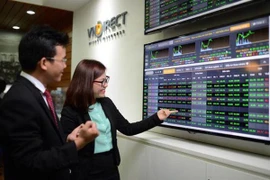 A customer borrows at a bank in Hanoi. By the end of June this year, credit growth was only 4.03%, against 9.4% of the same period last year, the lowest credit growth in the past ten years. (Photo: VNA)
A customer borrows at a bank in Hanoi. By the end of June this year, credit growth was only 4.03%, against 9.4% of the same period last year, the lowest credit growth in the past ten years. (Photo: VNA)BIDV recently announced to set aside 300 trillion VND for loans with apreferential annual interest of 0.5-2% lower than normal lending rates.
Pham Thi Van Khanh, director of BIDV's corporate banking division, said theywill specify conditions in the implementation of the low-interest loan packageso as to help qualified firms access the capital.
A representative of Agribank said the bank has just adjusted lending interestrates lower for the sixth time. For loans aimed at production and businessactivities, the short-term lending interest rate is only from 5% annually, andthe rate for medium- and long-term loans starts from 8% per year. Thesepackages are part of a programme of 100 trillion VND and 500 million USD forcorporate customers.
LPBank has also decided to expand the preferential credit package to 10trillion VND for production and business loans in both urban and rural areas.Under the package, interest rates are from 7.5% per year for corporatecustomers and 8.5% per year for retail ones.
Surveys in banks such as VietinBank, Vietcombank, TPBank, Sacombank and MSBshow preferential loan packages currently have interest rates from 0.5 to 2%lower per year depending on customer groups.
In addition, many banks have reduced operating costs to support firms throughpolicies on exemption and reduction of money transfer service fees or reductionof import and export payment fees.
Some banks said they could not reduce lending interest rates for outstandingloans immediately as the input capital for the loans was mobilised with highinterest rates while the loan interest rate adjustment cycle under banks’credit contracts was often from three to six months.
However, for new loans, banks are lowering lending interest rates to stimulatecredit demand under the current context that input interest rates have fallensharply and credit growth is very low.
By the end of June this year, credit growth was only 4.03%, against 9.4% of thesame period last year, the lowest credit growth in the past ten years.
According to banking expert Dr. Nguyen Tri Hieu, interest rates are in adownward trend, but the risks of the economy are increasing, which means thatbanks will be more cautious when lending and it is not easy for firms toborrow.
For firms, the demand for loans is only moderate due to difficulties in themarket and slow sales of goods. Firms will boldly borrow capital only when theeconomy recovers.
A representative of Maybank Securities Company also said although the StateBank of Vietnam (SBV)’s policy interest rate was reduced four times, thelending interest rate is still anchored at a high level. This is mainly becausebanks are stuck with high-cost capital raised last year and in the first monthsof this year. However, high-interest deposits are gradually coming to maturityso lending rates will continue to decrease in the near future.
In order for the lending interest rate to return to normal, it must be reducedby about 1.5 percentage points compared to the current rate. In addition, theSBV’s policy interest rate can be reduced by at least 50 basis points withinthe next three months, a Maybank representative said.
International banks in Vietnam such as HSBC, UOB, and Standard Chartered allalso expect the SBV to continue to cut the refinancing interest rate by another50 basis points to 4.0% in the third quarter (the equivalent rate during thepandemic years) and keep the rate unchanged until the end of 2024 and 2025.
Under Resolution No. 97/NQ-CP of the Government’s regular meeting in June 2023,the SBV, in conjunction with other relevant ministries and agencies, will tocontinue lowering interest rates, especially lending rates, by at least 1.5 to2 percentage points per year for both new and outstanding loans./.





























